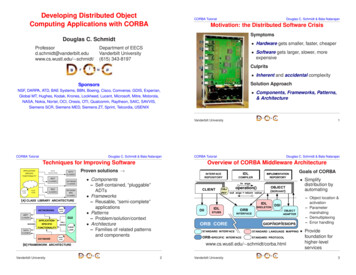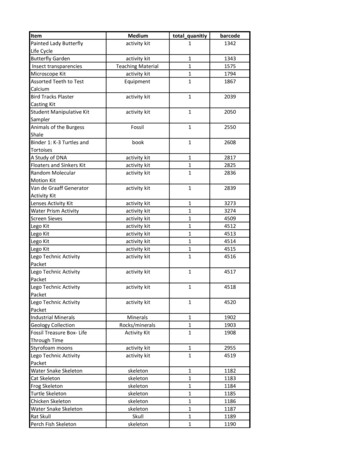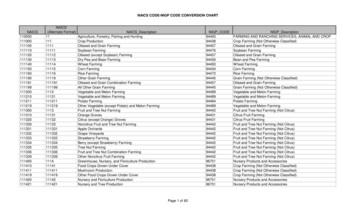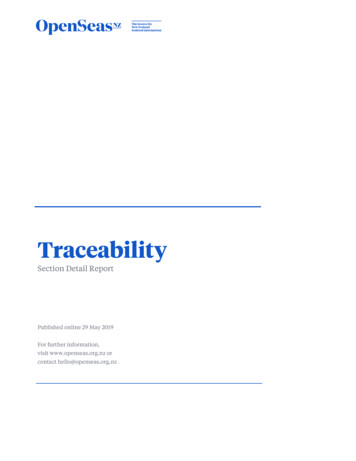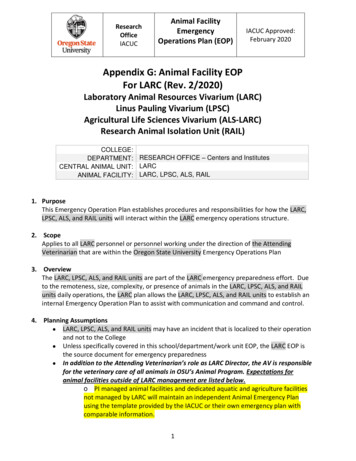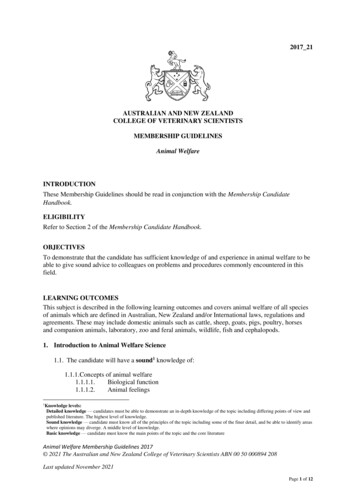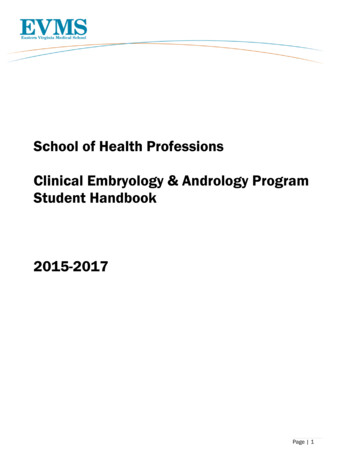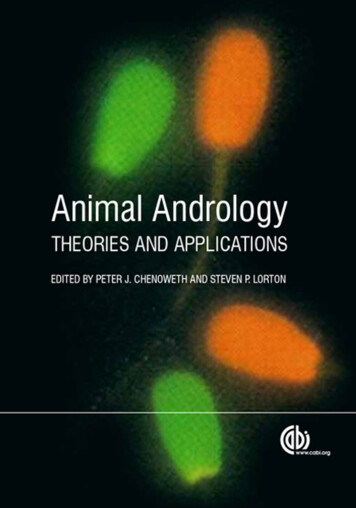
Transcription
Animal AndrologyTheories and Applicationswww.fiqahjafria.com
Peter J. ChenowethTo my parents (deceased) who instilled the desire for knowledge, andto Lee who has been my support and counsel.Steven P. LortonTo Lynn C. Lorton, my wife, best friend and my best supporter.To Joseph Curtis (deceased), Neal First, James Mrotek and John Reynolds,early mentors who sparked my interest in research and sperm in particular,and who have been my friends for more than 40 years.www.fiqahjafria.com
Animal AndrologyTheories and ApplicationsEdited byPeter J. ChenowethChenoVet Animal Andrology, Wagga Wagga, New South Wales, AustraliaSteven P. LortonReproduction Resources, Walworth, Wisconsin, USAwww.fiqahjafria.com
CABI is a trading name of CAB InternationalCABINosworthy WayWallingfordOxfordshire OX10 8DEUKCABI38 Chauncey StreetSuite 1002Boston, MA 02111USATel: 44 (0)1491 832111Fax: 44 (0)1491 833508E-mail: info@cabi.orgWebsite: www.cabi.orgTel: 1 800 552 3083 (toll free)Tel: 1 (0)617 395 4051E-mail: cabi-nao@cabi.org CAB International 2014. All rights reserved. No part of this publicationmay be reproduced in any form or by any means, electronically, mechanically,by photocopying, recording or otherwise, without the prior permission ofthe copyright owners.A catalogue record for this book is available from the British Library,London, UK.Library of Congress Cataloging-in-Publication DataAnimal andrology : theories and applications / [edited by] Peter J. Chenoweth,Steven P. Lorton.p. cm.Includes bibliographical references and index.ISBN 978-1-78064-316-8 (hbk)1. Domestic animals--Reproduction--Endocrine aspects. 2. Andrology.3. Spermatozoa. I. Chenoweth, Peter J., editor of compilation. II. Lorton,Steven P., editor of compilation.[DNLM: 1. Reproductive Techniques, Assisted--veterinary. 2. SemenPreservation--veterinary. 3. Sperm Retrieval--veterinary. 4. VeterinaryMedicine--methods. SF 871]SF871.A55 2014636.08'24--dc232013042144ISBN-13: 978 1 78064 316 8Commissioning editor: Sarah Hulbert / Julia KillickEditorial assistant: Emma McCannProduction editor: Lauren PoveyTypeset by SPi, Pondicherry, India.Printed and bound in the UK by CPI Group (UK) Ltd, Croydon, CR0 4YY.www.fiqahjafria.com
ContentsviiContributorsixPrefacePART I. ANIMAL ANDROLOGY THEORIES31Semen and its ConstituentsBrian P. Setchell2Sperm Production and its HarvestWilliam E. Berndtson113Determinants of Sperm MorphologyAbdullah Kaya, Sema Birler, Lefric Enwall and Erdogan Memili344Sperm Preparation for FertilizationBart M. Gadella575Fundamental and Practical Aspects of Semen CryopreservationWilliam V. Holt and Linda M. Penfold766Evaluation of Semen in the Andrology LaboratorySteven P. Lorton1007Genetic Aspects of Male ReproductionPeter J. Chenoweth and Francoise J. McPherson144PART II. ANIMAL ANDROLOGY APPLICATIONS8Applied Small Animal AndrologyMargaret V. Root Kustritz1779Applied Andrology in Chickens and TurkeysJulie A. Long197Applied Andrology in Sheep, Goats and Selected CervidsSwanand Sathe and Clifford F. Shipley22610vwww.fiqahjafria.com
viContents11Applied Andrology in HorsesBarry A. Ball25412Applied Andrology in Cattle (Bos taurus)Leonardo F.C. Brito29713Applied Andrology in Cattle (Bos indicus)Jorge Chacón35214Applied Andrology in Water BuffaloSayed Murtaza H. Andrabi38015Applied Andrology in SwineGary C. Althouse40416Applied Andrology in CamelidsAhmed Tibary, Lisa K. Pearson and Abelhaq Anouassi41817Applied Andrology in Endangered, Exotic and Wildlife SpeciesRebecca Spindler, Tamara Keeley and Nana Satake45018Male Animal ContraceptionScott T. Norman and Tonya M. Collop47419Semen Evaluation and Handling: Emerging Techniquesand Future DevelopmentHeriberto Rodriguez-Martinez509551Indexwww.fiqahjafria.com
ContributorsGary C. Althouse, Department of Clinical Studies, School of Veterinary Medicine, Universityof Pennsylvania, New Bolton Center, 382 West Street Road, Kennett Square, PA 19348, USA.E-mail: gca@vet.upenn.eduSayed Murtaza H. Andrabi, Animal Reproduction Programme, Animal Sciences Institute, NationalAgricultural Research Centre, Park Road, Islamabad, Pakistan. E-mail: andrabi123@yahoo.comAbdelhaq Anouassi, Veterinary Research Centre, PO Box 77749, Abu Dhabi, United ArabEmirates. E-mail: anouassi@yahoo.comBarry A. Ball, Gluck Equine Research Center, Department of Veterinary Sciences, University ofKentucky, Lexington, KY 40546-0099, USA. E-mail: b.a.ball@uky.eduWilliam E. Berndtson, Department of Biological Sciences, University of New Hampshire,Durham, NH 03824, USA. E-mail: bill.berndtson@unh.eduSema Birler, Department of Reproduction and Artificial Insemination, Faculty of VeterinaryMedicine, University of Istanbul, 34320, Istanbul, Turkey. E-mail: sbirler@istanbul.edu.trLeonardo F.C. Brito, ABS Global, Inc., 1525 River Road, DeForest, WI 53532, USA. E-mail:leo.brito@genusplc.comJorge Chacon, Research Program on Applied Animal Andrology, School of Veterinary Medicine,Universidad Nacional (UNA), Heredia, Costa Rica. E-mail: jorge.chacon.calderon@una.crPeter J. Chenoweth, ChenoVet Animal Andrology, 22 Peter Street, Wagga Wagga, NSW 2650,Australia. E-mail: peter1@chenovet.com.auTonya M. Collop, Missouri Department of Agriculture, 1616 Missouri Boulevard, JeffersonCity, MO 65102, USA. E-mail: tcollop@hotmail.comLefric Enwall, New Tokyo Medical College, Kolonia, Pohnpei, Federated States of Micronesia.E-mail: lefricenwall@yahoo.comBart M. Gadella, Departments of Farm Animal Health and Biochemistry and Cell Biology, Facultyof Veterinary Medicine, Utrecht University, Yalelaan 2, 3584 CM Utrecht, the Netherlands.E-mail: b.m.gadella@uu.nlWilliam V. Holt, Academic Department of Reproductive and Developmental Medicine,University of Sheffield, Sheffield S10 2SF, UK. E-mail: bill.holt@ioz.ac.ukAbdullah Kaya, Alta Genetics Inc, N8350 High Road, PO Box 437, Watertown, WI 53094, USA.E-mail: akaya@altagenetics.comTamara Keeley, School of Agriculture and Food Sciences, University of Queensland, Gatton,Queensland 4343, Australia. E-mail: zooreproduction@yahoo.comviiwww.fiqahjafria.com
viiiContributorsJulie A. Long, Beltsville Agricultural Research Center, US Department of Agriculture, AnimalResearch Service, Beltsville, MD 20705, USA. E-mail: julie.long@ars.usda.govSteven P. Lorton, Reproduction Resources, Inc., 400 S. Main Street, Walworth, WI 53184, USA.E-mail: splorton@alumni.clarku.eduFrancoise J. McPherson, Charles Sturt University, Boorooma Street, Wagga Wagga, NSW 2678,Australia. E-mail: fmcpherson@csu.edu.auErdogan Memili, Department of Animal and Dairy Sciences, Mississippi State University,Mississippi State, MS 39762, USA. E-mail: em149@ads.msstate.eduScott T. Norman, School of Animal and Veterinary Sciences, Charles Sturt University, BooroomaStreet, Wagga Wagga, NSW 2678, Australia. E-mail: snorman@csu.edu.auLisa K. Pearson, Department of Veterinary Clinical Sciences, College of Veterinary Medicine,Washington State University, Pullman, WA 99164-6610, USA. E-mail: pearsonlk@vetmed.wsu.eduLinda M. Penfold, South-East Zoo Alliance for Reproduction & Conservation, Yulee, FL 32097,USA. E-mail: lindap@wogilman.comHeriberto Rodriguez-Martinez, Department of Clinical and Experimental Medicine, Facultyof Health Sciences, Linköping University, SE-581 85 Linköping, Sweden. E-mail: heriberto.rodriguez-martinez@liu.seMargaret V. Root Kustritz, Department of Veterinary Clinical Sciences, College of VeterinaryMedicine, University of Minnesota, 1352 Boyd Avenue, St Paul, MN 55108, USA. E-mail:rootk001@umn.eduNana Satake, School of Veterinary Sciences, University of Queensland, Gatton Campus,Gatton, Queensland 4343, Australia. E-mail: nanastake@gmail.comSwanand Sathe, Department of Veterinary Clinical Sciences, Lloyd Veterinary Medical Center,College of Veterinary Medicine, Iowa State University, 1600 S 16th Street Ames, IA 50011,USA. Email: ssathe@iastate.eduBrian P. Setchell, School of Medical Sciences, University of Adelaide, Adelaide, SA 5005,Australia. E-mail: brian.setchell@adelaide.edu.auClifford F. Shipley, College of Veterinary Medicine, University of Illinois, 1008 West HazelwoodDrive, Urbana, IL 61802, USA. E-mail: cshipley@illinois.eduRebecca Spindler, Taronga Zoo, Taronga Conservation Society Australia, Bradley’s HeadRoad, Mosman, NSW 2088, Australia. E-mail: rspindler@zoo.nsw.gov.auAhmed Tibary, Department of Veterinary Clinical Sciences, College of Veterinary Medicine,Washington State University, Pullman, WA 99164-6610, USA. Email: tibary@vetmed.wsu.eduwww.fiqahjafria.com
PrefaceMotivation for this volume on applied animal andrology derives from a number of sources.Firstly, the science of andrology (or male reproduction) is rapidly evolving. Fifty years ago, fewwould have envisaged today’s capabilities, which include identifying specific genomic sitesfor factors directly affecting male reproduction including those associated with sex-relateddefects or disease. Reproductive technologies such as cryopreservation, in vitro fertilization(IVF) and intracytoplasmic sperm injection (ICSI) have become routine andrological procedures. In the animal world, these complement established technologies such as those used foroestrous detection and synchronization, artificial breeding and embryo transfer. Rapidlyevolving technologies such as molecular and cell biology, proteomics and genomics are transforming animal reproduction and livestock production as well as our capabilities to conservethreatened and endangered species. Such progress becomes even more astounding when oneconsiders that frozen semen AI (artificial insemination) has been routinely applied in livestockfor only 60 years, the recognition of male factor infertility extends back scarcely 100 years andit is less than 250 years since Antonie van Leeuwenhoek used an ‘advanced-magnifier microscope’ to describe ‘animalcules’ within an ejaculate.An outcome of this accelerating tsunami of knowledge is that it is becoming very challenging for experts in the field to remain abreast of relevant advances in andrology, let alonefor those who should benefit from their practical application. Andrology itself is becoming socompartmentalized that the exchange of information across its different sub-disciplines is constrained and it is becoming more and more difficult to maintain an overview. Not too manyyears ago, there were several pertinent scientific journals only, while today there is a profusionof them. Indeed, Thaddeus Mann and Cecilia Lutwak-Mann could hardly have envisaged thescope of subsequent developments when they wrote the following preface to their landmarkbook, Male Reproductive Function and Semen, in 1980: ‘To present a coherent and meaningfulsurvey of scientific research endeavour in an area that has expanded so rapidly as physiologyand biochemistry of reproduction in the male is no mean feat these days’. However, despite theaccumulation of more and better knowledge, or perhaps because of the volume and complexities involved, it is apparent that practical implementation of many potential benefits is eithernot occurring or is being unnecessarily delayed. There is an evident need to facilitate the flowof information between animal andrological science and its potential end users.Such considerations present both challenges and opportunities in attempting to producea compendium that summarizes current knowledge and wisdom in animal andrology.ixwww.fiqahjafria.com
xPrefaceExperience from over 40 years of teaching animal reproduction to veterinary and animalscience students in both the USA and Australia (PJC) indicates that such a text could representa useful and relevant resource. Another thread comes from long experience with the livestockartificial breeding industries (SPL), in which warm support for such a book has been expressed.An additional important consideration is the pressing need to boost animal protein production in developing countries, where a burgeoning human population is causing increasedstress on food resources. Here, livestock productivity is often low; a situation compounded bypoor reproductive rates. Although it is conceded that a number of factors are involved in thisscenario, there is general acceptance of the need for widespread dissemination and adoptionof the basic precepts of good reproductive management.Similar sentiments to those above led to the formation in 1997 of the ‘Association for AppliedAnimal Andrology’ (4A; see http://www.animalandrology.org/), which aspires to improve networking and understanding in the discipline of andrology as applied to those animals that are ofdirect use to mankind. A major founding objective of 4A was to help provide an effective conduitso that current scientific knowledge in andrology can be translated into practices that can directlybenefit animal reproduction. This objective is considered to be even more pertinent today, whenartificial breeding of many species – e.g. cattle, horses, sheep, deer, dogs, pigs, camelids, chickens, zoo animals – has become so widespread, and superior animal genetics, in the form of liquidor frozen semen, are routinely transported across continents.In this situation, relevant knowledge and expertise are at a premium, both in developed anddeveloping countries. However, despite an increasing demand for competent animal reproduction/andrology expertise and services, opportunities for appropriate education and training aredecreasing. Thus, this text aims to provide useful information for those teaching animal physiology at a tertiary level (and possibly at high secondary level), as well as a reference for thoseinterested in male animal reproductive evaluation (and performance), and in semen evaluation,handling and use for artificial breeding. The book attempts to provide the necessary basic information, and this then leads to informed evaluation of male reproductive function in domesticand exotic species (including semen collection, preservation and evaluation) and newer developments in animal andrology, including advanced reproduction techniques (ART).As editors, we would be extremely remiss if we did not acknowledge the immense contributions made to animal andrology over many years by dedicated scientists from a numberof disciplines, including andrology, gynaecology, biochemistry, physiology, physics, and animal and veterinary science. The list of individuals who deserve appropriate recognition isindeed long, and in the current context we can only attempt to mention some who have madeexceptional contributions in terms of applied animal andrology, in the sure knowledge thatwe have inadvertently omitted worthy candidates. This book is dedicated to several individuals who have had significant influence on either of the editors. Other names that shouldbe duly recognized within this context include: J.O. Almquist; R.P. Amann; L. Ball; A. Bane;J. Bedford; W. Bielanski; A.W. Blackshaw; E. Blom; T. Bonadonna; B. Brackett; M.C. Chang;B.G. Crabo; H.M. Dott; P. Dzuik; D.W. Fawcett; R.H. Foote; D. Galloway; D. Garner; R.M.C.Gunn; J. Hammond; R.A.P. Harrison; A. Iritani; L.A. Johnson; R. Jones; N. Lagerlof; A. Laing;H. Lardy; T. Mann; W.G.R. Marden; D. Mortimer; H.G. Osborne; B.W. Pickett; C. Polge; L.E.A.Rowson; R. Saacke; G.W. Salisbury; B.P. Setchell; S. Solomon; M. Tischner; G.M.H. Waites;W.W. Williams; and R. Yanagimachi.We believe that the contributing authors to this volume are cut from similar cloth, andrepresent today’s animal andrology leaders in their respective categories. We are immenselyproud that such a sterling team, drawn from North and South America, Australasia, Micronesia,Europe, the Middle East and Pakistan, has been assembled for the task. We are most appreciative of their efforts and patience in the preparation of this tome, as we are of the staff of CABI,Sarah Hulbert and Emma McCann, and Connie Clement, our Australian editorial assistant.Peter J. Chenoweth and Steven P. Lortonwww.fiqahjafria.com
Part IAnimal Andrology Theorieswww.fiqahjafria.com
This page intentionally left blankwww.fiqahjafria.com
1Semen and its ConstituentsBrian P. Setchell*University of Adelaide, Adelaide, South AustraliaIntroductionSemen, the material that is emitted from thepenis at ejaculation, comprises a cellular component, the spermatozoa, and a liquid phase,the seminal plasma. The volume of semen ina single ejaculate varies widely among thedomesticated mammals, from about 1 ml insheep and goats to as much as half a litre inpigs. The density of spermatozoa also varies,being much higher in those species withsmall ejaculates and lower in those ejaculating large volumes.Semen is composed of secretions of theampulla of the ductus deferens, and of theaccessory glands, seminal vesicles and prostate, as well as fluid and spermatozoa fromthe cauda epididymis. Individual components may have different origins.Composition of SemenA large amount of information is nowavailable about the structure of the spermatozoa, and for details the reader is referredto the many detailed reviews on this topic(Bishop and Walton, 1960; Phillips, 1975;Bedford and Hoskins, 1990; Gage, 1998;Bedford, 2004; Eddy, 2006). In brief, thespermatozoa of the domestic mammalshave spatulate heads containing the nuclearDNA, with an acrosome covering the anterior pole, attached by a specialized neckstructure to a midpiece and tail. The midpiece consists of a helix of mitochondriasurrounding the central two and surrounding nine fibres, which extend into the tail.The sperm of the domestic mammals arerelatively small, at least when comparedwith those of most rodents, and are similarin size and structure to human sperm. Thesperm of most murid rodents are muchlarger and quite different in shape, beingfalciform or hook shaped, with the acrosome over one side of the head.SpermatozoaOther cellsThe fraction of the semen made up by spermatozoa is known as the spermatocrit, andranges from more than 30% in sheep to lessthan 2% in pigs (Table 1.1).As well as spermatozoa, white blood cells(WBC) are often found in semen. In humans,more than 10 WBC/ml semen is often associated* E-mail: brian.setchell@adelaide.edu.au CAB International 2014. Animal Andrology: Theories and Applications(eds P.J. Chenoweth and S.P. Lorton)www.fiqahjafria.com3
4B.P. SetchellTable 1.1. Some details of the composition of the semen of the domestic animals. Based on data fromMann, 1964; Mann and Lutwak-Mann, 1981. Reproduced from Setchell, 1991, with permission from Elsevier.SemenDry weight (%)pHSpecific gravitySperm concentration( l06/ml)Spermatocrit (%)Volume (ml)Seminal plasmaAcetylglucosaminidase(units/ml)Ascorbic acid (mg/100 ml)Bicarbonate (mmol/l)Calcium (mmol/l)Chloride (mmol/l)Citric acid (mg/100 ml)Ergothioneine (mg/100 ml)Fructose (mg/100 ml)Glutamic acid (mg/100 ml)Glycerylphosphorylcholine(mg/100 ml)Inositol (mg/100 ml)Magnesium (mmol/l)Mannosidase (units/ml)Potassium (mmol/l)Protein (g/100 ml)Sodium (mmol/l)Sorbitol (mg/100 ��6.5–8–533.5–13.7 hole semen.with infertility (Wolff, 1995), although this viewis now not universally accepted (Aitken andBaker, 1995; Lackner et al., 2010; Tremellen andTunc, 2010; Henkel 2011). In domestic mammals, WBC are often present in small numbersin semen, although there appears to be no relationship between their numbers and abnormalities of the sperm (Sprecher et al., 1999;Sutovsky et al., 2007; Alghamdi et al., 2010).CarbohydratesOne of the most remarkable features of semenis that the predominant reducing sugar isnot glucose, as in blood, but fructose (Mann1946a,b), a sugar more usually found in plants.Small amounts of glucose are also present,and boar semen in particular contain largeconcentrations of inositol, but less fructosethan semen from bulls or rams (Mann, 1951).Stallion semen also contains inositol andlower concentrations of fructose (Baronos,1951; Mann et al., 1963), and other compoundsof inositol are also present in some species(Seamark et al., 1968). Fructose in bulls andrams originates in the seminal vesicles, withsome from the ampulla, but in the stallion,most comes from the ampulla. Inositol issecreted in the seminal vesicles (Mann andLutwak-Mann, 1981).Both glucose and fructose can be utilizedby sperm, either by oxidation or glycolysis,although the Michaelis constant (Km) for glucose is much lower than that for fructose (seeFord and Rees, 1990). The mitochondria, inwhich oxidative phosphorylation occurs, arewww.fiqahjafria.com
Semen and its Constituentsarranged as a helix around the midpiece ofthe sperm, whereas the glycolytic enzymesare concentrated in the principal piece of thetail, while some are bound to the fibroussheath of the flagellum. However, it is unlikelythat glycolysis alone could generate enoughATP for full motility, and while diffusionfrom the mitochondria may be sufficient insmaller sperm, in larger sperm it is likely thatan adenylate kinase shuttle is involved inmoving ATP from the mitochondria to the flagellum (Ford, 2006; Miki, 2007; Storey, 2008;Cummins, 2009). There is evidence for theoccurrence in sperm of specific glucose transporters that can transport both glucose andfructose (Purcell and Moley, 2009).Proteins, amino acids and othernitrogen-containing compoundsSeminal plasma contains a variety of proteinsand peptides, the total concentration beingsomewhat less than that in blood plasma (Mannand Lutwak-Mann, 1981). Seminal plasma proteins are derived from the epididymis and theaccessory glands, and are involved in severalessential steps preceding fertilization, including capacitation, establishment of the oviductal sperm reservoir, modulation of theuterine immune response, sperm transportin the female tract and gamete interactionand fusion (Calvete et al., 1994; Topfer-Petersenet al., 2005; Karekoski et al., 2011).Some proteins are higher in the semen offertile bulls, whereas others are more abundant in the semen of bulls of lower fertility(Killian et al., 1993; Bellin et al., 1998; Brandonet al., 1999). In stallions, the abundance ofsome proteins (kallikrein-1E2, clusterin andseminal plasma proteins 1 and 2 (SP1 and 2)are negatively related to fertility, whereascysteine-rich secretory protein 3 (CRISP3) ispositively related (Novak et al., 2010).Other proteins are involved in sperm–egg interactions and cell cycle regulation(Gaviraghi et al., 2010). Identified proteinsinclude leptin and insulin-like growth factor I(IGF-I; Lackey et al., 2002) and phospholipidbinding proteins involved in sperm membrane lipid modification during capacitation5(Manjunath and Therien, 2002). Seminalplasma from stallions contains SSP-7 (stallionseminal protein 7, also known as horse seminal protein 7 – HSP-7), a member of the spermadhesin protein family that is involved inthe sperm binding to the zona pellucida of theoocyte (Reinert et al., 1997), and there are alsoheparin-binding proteins, which modulatecapacitation (Miller et al., 1990; Nass et al.,1990; Bellin et al., 1994). Other proteins inhibitin vitro and cooling-induced capacitation(Vadnais and Roberts, 2010) and the ability ofsperm to penetrate zona-free oocytes (Henaultet al., 1995; Henault and Killian, 1996), as well assperm transport and elimination (Troedssonet al., 2005), sperm longevity (Karekoski andKatila, 2008) and storage in the oviduct(Gwathmey et al., 2006). Seminal plasma frompigs contains high concentrations of transforming growth factor b (TGF-beta), an important immune deviating agent (Robertson et al.,2002).Seminal plasma also contains considerable concentrations of free amino acids, particularly glutamic acid in rams and bulls(Setchell et al., 1967; Brown-Woodman andWhite, 1974) and hypotaurine in boars (Van derHorst and Grooten, 1966; Johnson et al., 1972).Hypotaurine may be important in preventingdamage to sperm by reactive oxygen species(Alvarez and Storey, 1983; Bucak et al., 2009).There are also appreciable concentrations of carnitine in the seminal plasma oframs (Brooks, 1979), bulls (Carter et al., 1980)and stallions (Stradaioli et al., 2004). This substance is involved in fatty acid transportin other tissues, but that present in semen islargely derived from the epididymis (Hintonet al., 1979). Boar semen also contains ergothioneine, the betaine of thiolhistidine, asulfur-containing reducing base, which comesmainly from the seminal vesicle (Mann andLeone, 1953); it is also present in stallionsemen, but in this species, it originateslargely from the ampulla (Mann and LutwakMann, 1963).Semen and seminal plasma from rams,bulls, goats, boars and stallions were found tocontain considerable amounts of glycerophosphorylcholine, which originates largely fromthe epididymis (Dawson et al., 1957; Brooks1970), as well as glycerylphosphorylinositol.www.fiqahjafria.com
6B.P. SetchellLipidsFunction of SemenSemen contains considerable amounts oflipid, both neutral lipids and phopholipids,most of which is in the spermatozoa (Hartreeand Mann, 1959). In ram semen, the mostabundant phospholipid is choline plasmalogen (also known as phosphatidalcholine),whereas in boars, it is lecithin (also knownas phosphatidylcholine) and in bull sperm,the two phospholipids are present in approximately equal amounts (see Mann and LutwakMann, 1981). One remarkable feature of thesephospholipids is their high concentration ofhighly unsaturated fatty acids, 22 carbonsin length, with six double bonds (22:6) inrams and bulls and five double bonds (22:5)in boars (Johnson et al., 1969; Poulos et al.,1973; Evans and Setchell, 1978). These constituent fatty acids are particularly susceptible to damage from reactive oxygen species.The phospholipids may also be importantprecursors of platelet activating factor (PAF),which is probably involved in sperm motility,the acrosome reaction and fertilization, andwhich is found in bull and boar sperm (Parkset al., 1990; Roudebush and Diehl, 2001).Seminal plasma from bulls and stallions contains an acetylhydrolase, which may play arole in regulating autocrine or paracrine functions of PAF (Parks and Hough, 1993; Houghand Parks, 1994).Semen also contains appreciable concentrations of steroids. In bull semen, theconcentrations of several steroids, includingprogesterone, dihydrotestosterone, androstanediols and oestrogens are much higherthan in blood plasma. The oestrogens appearto come from the prostate, whereas theother steroids originate from the epididymis.Testosterone is present in seminal plasma atabout the same concentration as in bloodplasma, much less than in the rete testis fluidleaving the testis (Ganjam and Amann, 1976).Prostaglandins were discovered in the1930s, and were so named because it wasthought that they came from the prostate,but in fact they originate largely from theseminal vesicle in rams and bulls. They occurin smaller concentrations in the testis andepididymis (Voglmayr, 1973; Kelly, 1978).Transport of spermatozoaAn obvious function of the semen is the transport of the spermatozoa into the female reproductive tract at mating. The site of depositionvaries according to species; it is deposited intothe vagina in cattle and sheep, but directlyinto the uterus in pigs and to some extent inhorses. (Anderson, 1991). Movements of thefemale tract – which are probably importantin moving the spermatozoa from the site ofdeposition to that of fertilization – are probably influenced by some seminal constituents,in particular by prostaglandins (Kelly, 1978).Metabolism of spermatozoaIt has been argued that the spermatozoa arein contact with the seminal plasma for tooshort a time for metabolism of their constituents to be of major importance, but severalhours can elapse between mating and fertilization, so some utilization of metabolites,particularly of sugars, should be possible.However, the sperm probably also utilize cellular constituents, particularly lipids, duringthis time.Effects of seminal plasma on thefemale reproductive tractThe possible involvement of proteins inthe seminal plasma in the establishment ofoviductal sperm reserves, the capacitationof sperm and the processes of fertilization,including binding to and penetration of thezona pellucida of the oocyte, has alreadybeen mentioned. It should be remembered,though, that the conceptus must also be protected from maternal immune attack. This isachieved by the action of molecules in theseminal plasma that bind to receptors onfemale cells and activate gene expression,leading to modification in cellular composition, structure and function of local andremote tissues, such as the ovaries, spleenwww.fiqahjafria.com
Semen and its Constituentsand peripheral lymphoid organs (Murrayet al., 1983; Mah et al., 1985; Rozeboom et al.,2000; Robertson 2005, 2007).Seminal plasma induces a state of maternal immune tolerance, probably by mediationof T-regulatory cells (Robertson et al., 2009).Seminal plasma also facilitates early placentaldevelopment, promotes embryo attachment7and implantation, and regulates proliferation,viability and differentiation of embryonicblastomeres. There is also an effect on theinterval between the luteinizing hormone(LH) surge and ovulation, and even on subsequent behaviour of the inseminated female(O’Leary et al., 2002, 2004, 2006; Robertson,2005, 2007; Robertson et al., 2006).ReferencesAitken RJ and Baker HWG (1995) Seminal leucocytes: passengers, terrorists or good samaritans HumanReproduction 10 1736–1739.Alghamdi AS, Funnell BJ, Bird SL, Lamb GC, Rendahl AK, Taube PC and Foster DN (2010) Comparativestudies on bull and stallion seminal DNase activity and interaction with semen extender and spermatozoa Animal Reproduction Science 121 2
Bart M. Gadella, Departments of Farm Animal Health and Biochemistry and Cell Biology, Faculty of Veterinary Medicine, Utrecht University, Yalelaan 2, 3584 CM Utrecht, the Netherlands. E-mail: b.m.gadella@uu.nl William V. Holt, Academic Department of Reproductive and Developmental Medicine, University of Sheffield, Sheffield S10 2SF, UK.
